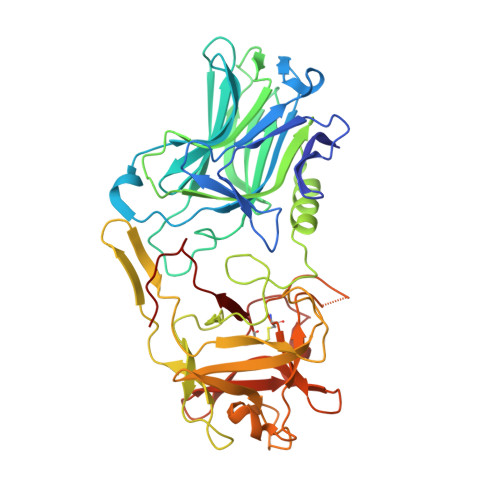Enhancing the Protective Immune Response against Botulism.
Przedpelski, A., Tepp, W.H., Kroken, A.R., Fu, Z., Kim, J.J., Johnson, E.A., Barbieri, J.T.(2013) Infect Immun 81: 2638-2644
- PubMed: 23670557
- DOI: https://doi.org/10.1128/IAI.00382-13
- Primary Citation of Related Structures:
4IQP - PubMed Abstract:
The need for a vaccine against botulism has increased since the discontinuation of the pentavalent (ABCDE) botulinum toxoid vaccine by the Centers for Disease Control and Prevention. The botulinum toxins (BoNTs) are the primary virulence factors and vaccine components against botulism. BoNTs comprise three domains which are involved in catalysis (LC), translocation (HCT), and host receptor binding (HCR). Recombinant HCR subunits have been used to develop the next generation of BoNT vaccines. Using structural studies and the known entry properties of BoNT/A, an HCR subunit vaccine against BoNT/A that contained the point mutation W1266A within the ganglioside binding pocket was designed. HCR/A(W1266A) did not enter primary neurons, and the crystal structure of HCR/A(W1266A) was virtually identical to that of wild-type HCR/A. Using a mouse model, experiments were performed using a high-dose vaccine and a low-dose vaccine. At a high vaccine dose, HCR/A and HCR/A(W1266A) elicited a protective immune response to BoNT/A challenge. At the low-dose vaccination, HCR/A(W1266A) was a more protective vaccine than HCR/A. α-HCR IgG titers correlated with protection from BoNT challenge, although titers to block HCR/A entry were greater in serum in HCR/A-vaccinated mice than in HCR/A(W1266A)-vaccinated mice. This study shows that removal of receptor binding capacity enhances potency of the subunit HCR vaccine. Vaccines that lack receptor binding capacity have the added property of limited off-target toxicity.
Organizational Affiliation:
Department of Microbiology and Molecular Genetics, Medical College of Wisconsin, Milwaukee, Wisconsin, USA.















